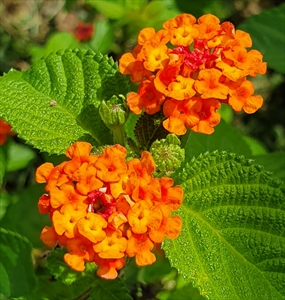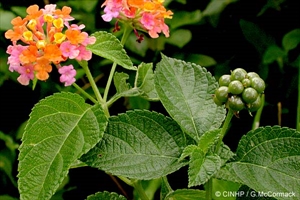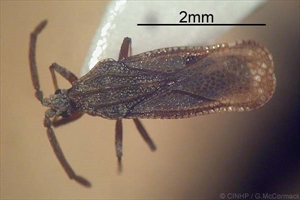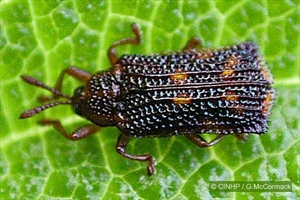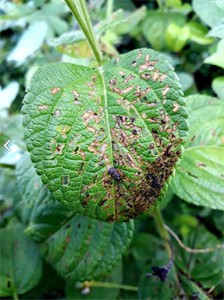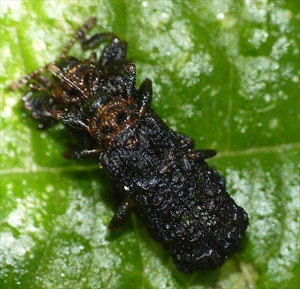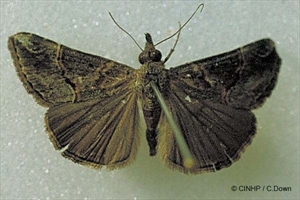- Widespread. Africa, Asia, North, South, Central America, the Caribbean, Europe, Oceania. In Australia and many Pacific island countries.
- An invasive bush that grows in dense impenetrable clumps or as climbing vines over large areas, threatening improved pastures, plantations, native vegetation and animals, creating home to vermin, shelter for organisms carrying human disease, and providing combustible material for hotter than usual bushfires. Livestock and children at risk from poisonous seeds.
- Stems square, with or without spines, leaves in opposing pairs, each about 6 cm long, bright green, with serrated margins, covered in fine hairs. Flowers in a cluster about 3 cm across, white, cream, pink, orange and red. Fruit berry-like, purplish-black when mature, producing numerous seeds, remaining viable for several years.
- Spread: layering, by birds and mammals, and long distances in horticultural trade.
- Biosecurity: listed by IUCN among 100 of World's Worst Invasive Species. National legislation is needed to control its importation and release.
- Natural enemies: many have been reported but it is still a problem weed because of the many varieties and environments where it thrives.
- Cultural control: dig out; slashing; raking, ploughing, bulldozing; burning; revegetation using improved pastures, ground legumes, trees. All methods require checking for regrowth, and perhaps herbicide spot-treatment.
- Chemical control: in Australia: 2,4,-D (amine); 2,4-D + picloram; fluroxypyr; fluroxypyr + aminopyralid; glyphosate (and Fiji); glyphosate + metsulfuron-methyl; triclopyr; picloram + triclopyr + aminopyralid; triclopyr + picloram; picloram + aminopyralid; metsulfuron-methyl (and Fiji).
Pacific Pests, Pathogens and Weeds - Online edition
Pacific Pests, Pathogens, Weeds & Pesticides
Lantana (434)
Lantana
Lantana camara. There are many sub-species and hundreds of varieties and hybrids of different colours, hairiness, thorniness, height, etc. that have been bred as ornamentals. There are also several species. Two groups are recognised worldwide: one with (few) or no spines (South and Central America, and the Caribbean), and the other with spines. The common variety in the Pacific islands is the one that is prickly. It is a member of the Verbenaceae.
AUTHORS Grahame Jackson & Aradhana Deesh
Information from 1Waterhouse DF, Norris KR (1987) Lantana camara Linnaeus Biological Control Pacific Prospects. Inkata Press. Melbourne; and Lantana (Lantana camara). Department of Agriculture and Fisheries. Biosecurity. Queensland; and CABI (2019) Lantana camara (lantana). Crop Protection Compendium. (https://www.cabi.org/cpc/datasheet/29771); and from CHAH (2011) Lantana camara L. WeedsAustralia - Profiles. Department of Sustainability, Environment, Water, Population and Communities. (https://profiles.ala.org.au/opus/weeds-australia/profile/Lantana%20camara). Photos 1,2&4 Gerald McCormak, Cook Islands Biodiversity & Natural Heritage. (http://cookislands.bishopmuseum.org). Photo 5 Coleoptera Chrysomedlidae t034 Octotoma scabripennis. Edithvale-Australia Insects. (https://www.flickr.com/photos/69610519@N08/6462736025/).
Produced with support from the Australian Centre for International Agricultural Research under project HORT/2016/185: Responding to emerging pest and disease threats to horticulture in the Pacific islands, implemented by the University of Queensland and the Secretariat of the Pacific Community.
